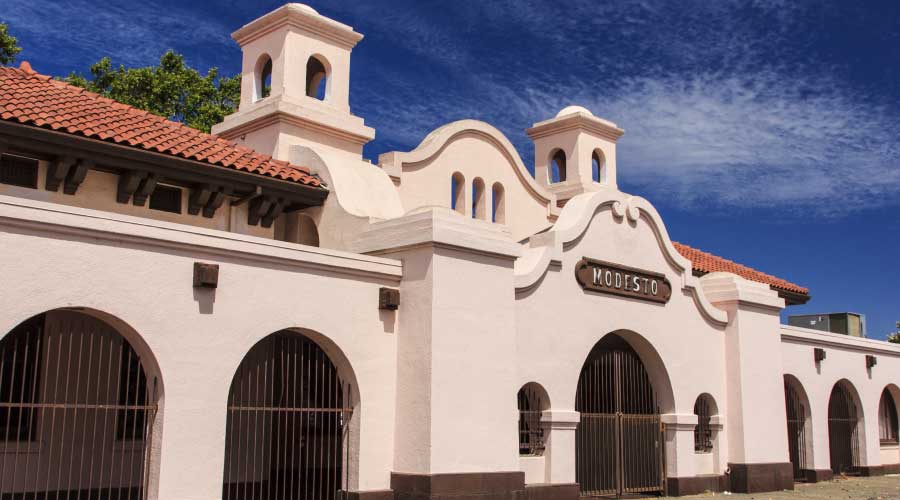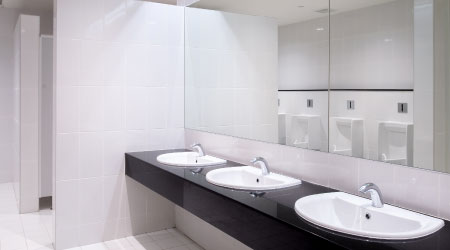Finding Refuge from Rising Water Rates
Improvements to sensor-controlled fixtures and to low- and no-flow toilets and urinals help keep expenses in check as facility executives aim to conserve water
Water conservation isn’t a novel concept, but emerging forces are creating renewed attention among commercial property owners. According to the Plumbing Manufacturer’s Institute, 36 states encompassing 90 percent of the population will experience water shortages by 2010. Because commercial buildings account for such a large portion of water usage, consuming between 9.5 billion and 10.6 billion gallons annually, facility executives will feel the pinch. With the prospect of water resources drying up, facility executives must find new ways to conserve water, experts say.
“I equate water conservation to the early days of energy conservation of the 1970s,” says Jim Allen, water conservation manager for Sloan Valve Co. “Water conservation hasn’t gotten to that level of visibility yet; however, we have finite water resources.”
Even in areas not hit by water shortages, expansion of wastewater treatment plants and the related infrastructure can drive up rates, says Jay Troger, president of Falcon Waterfree Technologies.
Fighting Rising Rates
Just in the last decade, water rates have risen 4 to 6 percent, and double-digit increases loom, especially in communities that must pipe water from substantial distances, says John Dommisse, director of marketing and product development for Bradley Corp.
To discourage waste, some communities — Santa Monica, Calif., for instance — are instituting billing structures in which consumers who use a lot of water pay more than light users, he says.
Federal legislation, such as the National Energy Policy Act (EPAct) of 1992, has also forced conservation issues to a certain degree. That law mandates that all toilets manufactured for commercial use consume no more than 1.6 gallons per flush (gpf). Urinals may not exceed 1.0 gpf. State and local governments have followed suit with even tighter restrictions, particularly in areas hit hard by drought.
While statistics vary according to building function, restrooms account for 40 to 50 percent of water use in most commercial settings. Kitchens, landscaping and HVAC systems typically account for the rest. That means the restroom is a logical point to begin examining water-saving measures.
Flushing toilets and turning faucets on and off were once hands-on activities, but more manufacturers are turning to electronics to control water flow automatically.
Public acceptance, however, was not automatic.
“In the past, electronic sensors struggled to gain public trust,” Allen says. “There were questions of whether they were actually going to operate.”
Indeed, early sensor devices had bugs, says Arnie Wikle, senior product applications manager for Bradley Corp. They were too easily fooled by outside lighting sources and there were even reports that automatic flush values and infrared faucet sensors were starting and stopping each other.
“Early devices had a lot of problems,” Winkle says. “Now infrared sensors are more adaptive, and there are fewer problems with ambient light setting them off.”
Sinks account for 15 percent of a restroom’s water volume, making faucets good candidates for sensor technology.
“Think about how you wash your hands,” says Jerry McDermott, executive vice president of Technical Concepts. “If you have a manual faucet, you have to turn it on, then get the temperature right. You wet your hands, put soap on them and then rinse. The whole time, the water is running.”
Infrared sensor-controlled faucets change that. They turn on only when water is really necessary.
On average, the return on investment for sensor devices is about 30 percent, McDermott says. “The higher the water costs, the higher the return. The lower the water costs, the lower the return. The payback period is about 18 months to three years.”
Maintenance requirements for sensor devices are determined by whether the electronics are hardwired or battery-operated. Hardwired products are harder and more expensive to install but require less maintenance than battery-operated devices.
Most battery-operated automated systems use standard batteries available at any store; some use rechargeable batteries.
At least one company manufactures faucets that generate their own electricity with an onboard microturbine. When the sensor activates and water runs, a mini hydropower station generates electricity and stores it in a lithium battery. The battery then powers the sensor, says Lenora Campos, public relations manager for TOTO USA. With this technology, the batteries can last 10 to 19 years.
Under normal circumstances, automated systems require little attention. Unfortunately, infrared sensors can be vandalized, Campos says. Faucet manufacturers have modified product designs to mitigate damage from vandals.
For example, new designs recess the electronic eye under the spigot. Other technologies eliminate the electronic eye, turning the entire sink into a sensor device.
Sensors combined with other faucet attachments can further reduce waste. For example, faucets can be fitted with aerators to cut water flow to 0.5 gallons per minute (gpm), saving up to 70 percent more water over traditional aerators, says Michael Rosen, commercial product manager for Chicago Faucets. An aerator costs less than $10 and takes about 15 minutes to install, says Rosen. In some drought-stricken communities, water districts offer aerators free of charge.
Down the Drain
Historically, the toilet is one of the restroom’s most voracious water hogs. Driven by federal mandate, however, plumbing manufacturers redesigned fixtures to the current 1.6 gpf standard.
Initial low-flow flush technology left users skeptical. At first, manufacturers simply recalibrated the tank, but the physics didn’t work well, Campos says. Users often needed to flush multiple times to satisfactorily remove waste. As a result, early models of low-flow toilets used more water than standard versions.
“When you talk about water conservation, you have to think about consumption and then performance,” Campos says.
Innovations that make the low-flow concept work include flush technologies that use the building’s line pressure to force waste from the bowl, advanced bowl designs, and surfaces that prevent matter from sticking to the fixture.
Urinals account for about 20 percent of a restroom’s water consumption. Before the 1.0 gpf standard, the typical urinal consumed 3.0 gpf. New waterless urinals use no water.
These urinals are similar in design to traditional fixtures, but there are no moving parts and only liquid can pass through the trap cartridge. Besides routine cleaning, these urinals only require a new disposable trap cartridge every three or four months, according to manufacturers. The disposable cartridge fits into the connecting pipe. It is designed to allow liquid to drain out of the fixture, but prevent odor and gas from backing up through the plumbing.
These urinals have a payback of less than two years, says Klaus Reichardt, managing partner for Waterless Co. Actual savings are determined by how frequently the urinals are used, how much water the original urinals used and local water rates.
To promote conservation, some municipal water districts offer rebates, free products and other incentives to businesses willing to use water-saving technologies.
Rebates range from as little as $5 for simple showerhead replacements to thousands of dollars for major retrofits. For example, Petaluma, Calif., offers $260 toward the purchase and installation of low-flow toilets and waterless urinals. Many of these rebates are accompanied by state and local laws that exceed the EPAct mandates.
In May, Arizona passed a law that requires the installation of waterless urinals in all new state buildings. Payson, Ariz., has an ordnance requiring buildings to use waterless urinals by 2006.
If government directives and financial incentives aren’t enough to convince facility executives to establish a water conservation program, then being recognized as an environmentally friendly corporate citizen might. Many businesses and manufacturers include in their corporate goals a promise to be environmentally sensitive and search for partners who help them meet that goal.
Often, they’ll turn to the LEED (Leadership in Energy and Environmental Design) green building rating system developed by the U.S. Green Building Council for help in evaluating environmentally friendly buildings.
To earn points for innovative wastewater technologies, a building must cut in half its use of municipally provided potable water for building sewage purposes or treat 100 percent of its wastewater on site to a level where it could be used for landscape irrigation. To earn points for water reduction, a building must trim water use by 20 percent after meeting the fixture performance requirements of EPAct.
The Environmental Protection Agency (EPA) is also working to make water conservation more convenient. In conjunction with the Plumbing Manufacturers Institute and water conservation advocates, EPA is exploring the feasibility of a water efficiency labeling system for plumbing products. The voluntary program, dubbed Water Star, would rate standard, off-the-shelf products on water use and performance.
The program would help buyers understand the benefits of water-efficient products, encourage plumbing manufacturers to continue research into water conservation technologies, and persuade water distributors and retailers to promote these products. The agency is expected to complete its study later this year.
Lynn Proctor Windle, a contributing editor to Building Operating Management, is a freelance writer who has written extensively about real estate.
Related Topics:











